The Birth of Venus is a famous work painted during the Italian Renaissance by Sandro Botticelli. It is believed to have been painted between 1482 and 1485. It is also believed that Botticelli was commissioned by the Medici family to paint this work as this piece hung in the country villa of the Medici. You can now visit the painting at the Uffizi Gallery in Florence, Italy.
In the painting, Venus, the goddess of love is centered, standing on a shell. To the left, you have Zephyr, the wind god, and (possibly) his wife Chloris, the goddess of flowers, blowing her to shore. On the right of Venus is Horae, the goddess of the spring getting ready to drape the fabric around Venus after her birth.
Medici Family
The Medici family is to thank for much of the success during the early Renaissance. Much of the famous Italian Renaissance artwork that we see in museums today was purchased by the Medici family as they found it important to study and preserve art. The Medici family oftentimes brought people they thought were talented in and gave them space to study and work. Sandro Botticelli was one of these lucky and talented men. As Botticelli was so close with the Medici family, he was very well known. He made a living by painting mostly religious scenes for people who were throwing themselves at him asking for paintings. The Birth of Venus was painted for member of the Medici family in Florence and kept in their country villa. Botticelli has the Medici family to thank for his successful career and the success of his painting, the Birth of Venus.
Botticelli’s Influences
Botticelli actually based his painting on an ancient sculpture of Venus as shown below. This sculpture is also in the Uffizi Gallery in Florence.
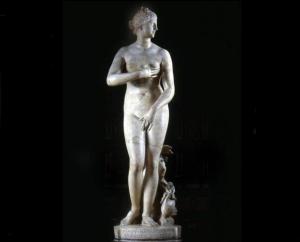 Another possible influence on Botticelli’s painting could be a love for the beautiful Simonetta Vespucci, wife of Marco Vespucci of Florence. Simonetta was so beautiful and loved by many, even by the Medici family. A humanist scholar and poet, known as Politian was friends with and studied under the Medici family. He wrote La giostra di Giuliano de’ Medici which is believed to have influenced Botticelli’s painting due to a similar scene being described in the poem. A Latin piece of literature known as Metamorphosis written by Roman poet Ovid, may have also influenced Botticelli’s painting as it also contains a descriptive scene that reads similarly to the scene portrayed in the Birth of Venus. Botticelli eventually met Simonetta and it is believed he used her as his model for his paintings of Venus. Sadly Simonetta died at the young age of 22. Some believe Botticelli was even in love with her as he wished to be buried at her feet when he died. After his death, it is said that his request was carried out and he was buried by Simonetta. Whether every bit of this is exactly true remains a mystery, but I like to believe it is.
Another possible influence on Botticelli’s painting could be a love for the beautiful Simonetta Vespucci, wife of Marco Vespucci of Florence. Simonetta was so beautiful and loved by many, even by the Medici family. A humanist scholar and poet, known as Politian was friends with and studied under the Medici family. He wrote La giostra di Giuliano de’ Medici which is believed to have influenced Botticelli’s painting due to a similar scene being described in the poem. A Latin piece of literature known as Metamorphosis written by Roman poet Ovid, may have also influenced Botticelli’s painting as it also contains a descriptive scene that reads similarly to the scene portrayed in the Birth of Venus. Botticelli eventually met Simonetta and it is believed he used her as his model for his paintings of Venus. Sadly Simonetta died at the young age of 22. Some believe Botticelli was even in love with her as he wished to be buried at her feet when he died. After his death, it is said that his request was carried out and he was buried by Simonetta. Whether every bit of this is exactly true remains a mystery, but I like to believe it is.
Botticelli also painted Primavera (shown beneath) which also contains Venus in the center. However, unlike in the Birth of Venus, Venus is clothed and it seems to be set in a later tim e. Simonetta was also assumed to be the model for this painting. The paintings were made to be hung next to one another as Primavera shows Venus at a more mature stage. This painting also hung up in the Medici villa and is now in the Uffizi Gallery.
e. Simonetta was also assumed to be the model for this painting. The paintings were made to be hung next to one another as Primavera shows Venus at a more mature stage. This painting also hung up in the Medici villa and is now in the Uffizi Gallery.
Similar paintings have been painted before, none of which became as famous and known as the Birth of Venus. The first known painting was the Venus Anadyomene (Venus Rising from the Sea) by Apelles which is sadly now lost. The photo below of the Mural at Pompeii is believed to be another copy of the Venus Anadyomene.
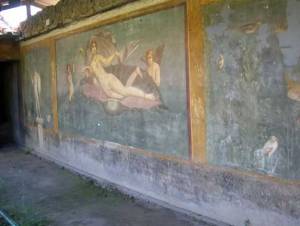
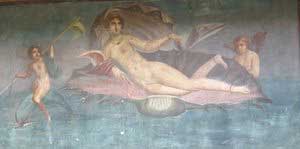
My Opinion
I especially like the Birth of Venus painting because I find it to be unique to most other Renaissance paintings. As was usual during this time period, most art work was very realistic with proper proportions. Bodies were standing in realistic poses. However, in the Birth of Venus, all the characters are floating. Venus herself seems to be floating over the shell for her stance would not allow her to realistically be standing like that without falling over or out of the shell. Another unique part of this painting is that besides Eve, women were not painted nude up until this time in the Renaissance. Understandably, this is the 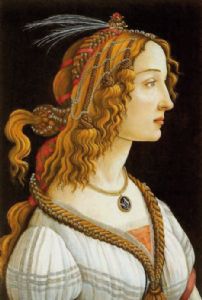 birth of Venus so it would seem strange for her to be clothed. It was also different from other artwork during this time because it was not a classical religious piece of work. I think I enjoyed this painting much more after doing a lot more research on it. I love the idea of Botticelli falling in love with Simonetta who is supposed to be portraying the goddess of love. On the right is another painting of Simonetta named Ritratto ideale Simonetta Vespucci by Botticelli. All the other possible influences make this painting more interesting along with the fact that the Medici family commissioned Botticelli to paint this painting and that it hung up in their villa. And that Botticelli most likely met Simonetta through the Medici family.
birth of Venus so it would seem strange for her to be clothed. It was also different from other artwork during this time because it was not a classical religious piece of work. I think I enjoyed this painting much more after doing a lot more research on it. I love the idea of Botticelli falling in love with Simonetta who is supposed to be portraying the goddess of love. On the right is another painting of Simonetta named Ritratto ideale Simonetta Vespucci by Botticelli. All the other possible influences make this painting more interesting along with the fact that the Medici family commissioned Botticelli to paint this painting and that it hung up in their villa. And that Botticelli most likely met Simonetta through the Medici family.
I enjoyed researching all the history behind the artwork and have realized that historic artwork like the paintings and sculptures from the Italian Renaissance have a huge amount of history behind them, more than I ever believed.
Works Cited
Acidini, Christina. “Simonetta Vespucci.” The Florentine. 10 May 2012. Web. 13 Sept. 2015.
“Birth of Venus by Sandro Botticelli.” Uffizi. Web. 13 Sept. 2015.
Finnan, Vincent. “The Birth of Venus by Sandro Botticelli.” Italian Renaissance Art. Web. 13 Sept. 2015.
Harris, Dr. Beth, and Dr. Steven Zucker. “Botticelli, Birth of Venus.” Khan Academy. Web. 13 Sept. 2015.
“Heilbrunn Timeline of Art History.” Angelo Poliziano: La Giostra Di Giuliano De’ Medici (The Joust of Giuliano De’ Medici) (25.30.22). The Metropolitan Museum of Art. Web. 13 Sept. 2015.
“La Primavera by Botticelli.” Uffizi. Web. 13 Sept. 2015.
“Medici, Godfathers of the Renaissance – Sandro Botticelli.” PBS. PBS. Web. 13 Sept. 2015.
Ovid. “Metamorphoses by Ovid.” The Internet Classics Archive. Trans. Sir Samuel Garth and John Dryden. Web. 13 Sept. 2015.
“Politian – Italian Poet and Humanist.” Encyclopedia Britannica Online. Encyclopedia Britannica, 2015. Web. 13 Sept. 2015.

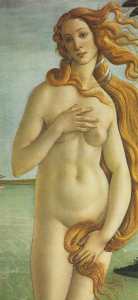
One of the most striking things that I see that ties Simonetta to the “Birth of Venus” is the actual face. If you look at the painting of Simonetta that you posted, and then go and closely look at the face of Venus in the “Birth of Venus”; the facial structure and features are almost identical. A very bold move by Botticelli, as Simonetta was a married women.
LikeLike
Beautifully well written and presented blog, however I’m curious, how did Botticelli first get introduced to the Medici family? Did they seek him out, or was he introduced to them by a friend? I appreciate that you chose this piece due to it’s uniqueness from other works of art during this time. I find it to be very beautiful and colorful. I can also agree that once you can actually sit down to do research on pieces of art, you can learn so much history from them. I see that you have written about the connection between the Birth of Venus to the Medici family, but I feel as though perhaps there was a more in-depth history that could have been included, like a little more background information. I do very much appreciate your blog, thanks for sharing.
LikeLike
Very well done! I have always loved this painting and it was nice to learn more of the history behind it. My question though is, you said that this was the first time a woman was painted nude – what kind of response did it get? I would think it would be a major controversy and outrage perhaps to have a fully naked woman painted by a male? Did you read into that at all or what was the response from the general public upon release of this painting? I would be interested to know.
LikeLike
@carlywells89 I came across that during research. The painting was actually kept behind closed doors for a long time due to it being such a controversial piece.
LikeLike
This was an amazing read and lesson in the Italian Renaissance. Do you think Simonetta felt the same way about Botticelli? I’m curious what the husband of Simonetta was thinking or felt when another guy was using his wife as a muse. What a great drama this would be for a screenplay or possibly opera.
LikeLike
The birth of Venus is a very unique and interesting piece of art in my opinion because Venus emerges from the sea as a full grown adult woman and this painting carries a very close similarity to the description presented in the poem Stanze per la giostra by Angelo Poliziano. You seem to have included many possible influences for this painting do you not also think that the Medici family directly influenced the reason the painting was started and their funds put towards it? I know you mentioned it in your intro but I think it was more of the direct influence under their standards.
LikeLike
You did such a thorough job and wonderful work here, I feel my choosing the Birth of Venus as the subject for my blog and how I did it pales in comparison to your work. I did intuit from what I read, before reading your blog that Botticelli was nurtured by the Medici’s almost exclusively. I’m curious, I read that people also thought that Botticelli might have been gay, though I did read about his burial processions and his wishes for his burial being carried out to the letter, as you wrote here (though unfortunately, wikipedia is not always the most reliable place for information, ha ha). I was curious if you had read the same, those rumors that he might have been gay? I think your sources are more credible than the ones I found when I chose this as well, and I was curious if you read about the themes that he was trying to convey through Primavera about love overcoming brutality? I loved reading this, you set this up very well! I think I need to take a lesson in doing blogs, I’m still not as familiar with how to set it all up with pictures and links and the like and yours looks amazing! I am impressed with the content, the layout, and of course, the fact that we both picked the same piece. It really was unique for its time wasn’t it?
LikeLike
This piece is one of my favorites. It is an excellent representation of the Medici family’s power. This is an evident representation of the influence they have on the Renaissance as a whole. I thought it was interesting that they commissioned painters such as Botticelli to paint for them, and because of this their name is now attached to the work as well. Another thing I found interesting is your explanation of the Gods incorporate in the art work and what they symbolize. This shows how prominent Roman Gods are the height of polytheism that dies out after them era ends. There was excellent observations in this blog about the resemblance of the faces as well, I would have never noticed that.
LikeLike
You did an amazingly thorough analysis of Botticelli’s work! I especially enjoyed your deep look into how the Medici Family influenced the creation of these masterpieces. Honestly, it has been very difficult to find information that you have not covered here. I will say that I too greatly appreciate the beauty and softness of Botticelli’s “Birth of Venus.” I suppose what I find most aesthetically pleasing in the work is the sense of movement. The viewer can almost feel the breeze that is flowing through the draping cloth that Horae brings to Venus. I also really enjoy the symbolism used through the mythical Gods and Goddesses–conveying joyful ideas of love, birth, and spring.
Once again, your analysis into Botticelli’s works and surrounding influences was a fascinating read, and I look forward to seeing more of your blog posts.
LikeLike
Using models has always been crucial to an artist’s ability to reproduce a visual presentation of someone / something. I have encountered speculation that the artist I researched also fancied a model in more than a professional way. However, the comment indicating that perhaps Botticelli’s sexual orientation was not towards women would be an argument that perhaps the artist(s) aren’t necessarily in love with their models in a romantic way, but simply in a visual way. Hairdressers, for example, certainly have clients they may favor for one reason or another, sometimes simply because a particular client wears a particular color / style exceptionally well which makes it easier to produce the visual effect goal. Often, I found myself favoring certain clients because I knew I could make a better presentation on them than on others. I don’t state this to be callous, simply because it may be what was occurring with these artists.
LikeLike
You did a truly amazing job describing all of these works of art. Like you, I also believe that The Birth of Venus is a very unique painting in this time period and is very beautiful. I think that it is interesting that Sandro Botticelli decided to focus so many paintings around this Venus. Because Venus is the goddess of love I feel like Sandro had a strong attachment to love, like maybe his life seemed to be impacted by love. I know in the sculpture you had said that he could have made it to look like Marco Vespuccis’ wife. I may be looking too much into it, but I know that when I write I usually have someone in mind and that most of my writing falls into love. In this time frame much of the paintings fall into what was going on at the time, but I think these pieces are so unique because maybe they were just specifically this individual and how he felt. Maybe he could only express himself through his artwork. Thank you for your piece on Botticelli.
LikeLike
I especially like your tying together of the works of different mediums. It is interesting to me that Botticelli had so many Venus pieces. Do you think that Botticelli fixated on Venus for a specific reason, if there is any? Thank you for sharing.
LikeLike
You did a great job on your blog. The Birth of Venus is a great piece by Sandro Botticelli and if it wasn’t for the Medici Family we wouldn’t have this artwork. Its just amazing how much the Medici Family had an effect on the history and the artwork during the Italian Renaissance. Like what you said in your blog, without the Medici Family we wouldn’t see all the artwork that we see in the Museums today. Do you think there was a specific reason why Botticelli used Venus as both of its centerpieces in both The Birth of Venus and Primavera?
LikeLike
You did an amazing job describing the history behind not only the painting but of what influenced Botticelli’s works. It’s pretty amazing to think that this one woman was the influence for a lot of his work. It really romanticizes the work you have shown. He really must have been in love if he could depict a woman so greatly detailed and replicate it in every work including her. I also didn’t know that this was the start of nude paintings of women. I can only imagine what a scandal it was to know such a painting existed behind closed doors!
LikeLike
You did an awesome job with your Birth of Venus blog! It was very well written and informative. I found it very interesting that the Medici family was also to thank for the artists’ success. I wrote about The Last Judgment by Michelangelo. Michelangelo also had the Medici family to thank for his success. They seem like they were a pretty awesome family because they took so many different artists in and allowed them to explore their creativity. I found your blog to be very similar to the one I was writing about because the figures in my painting were also painted nude. I also found that it was very unlikely back then that they be painted without clothes. Do you know if the Birth of Venus caused some criticism like the piece I wrote about? My favorite part about your blog was the influence Simonetta had on the artist. It doesn’t seem like they had much of a personal relationship but the influence she played in the artwork he painted was fascinating. And the fact that he wanted to be buried at her feet was pretty cool. Overall, great job! I really enjoyed reading about the Birth of Venus!
LikeLike
Nice history of the Medici family and The Birth of Venus! It is amazing how one family almost single-handedly facilitated the entire Italian Renaissance and all the beautiful art that came out of it. The Birth of Venus is one of those paintings that I’ve seen reproduced everywhere but don’t know anything about, so thanks for the history on it. I am glad that you brought up how it’s unique because it’s a secular painting; after going through the Renaissance course reading I noticed that this was one of the few secular paintings and thought that was interesting.
LikeLike
Emily, you made a great connection with the Medici Family and The Birth of Venus. It’s amazing that beautiful sculptures, paintings, and other forms of art may not have ever existed without the Medici family. Their power and ability to request works of art to be made for them essentially paved the way for some artists to be more successful and create works that other wise may have never existed. And I couldn’t agree more with you on the Birth of Venus being so unique. Other paintings of the era were a lot more basic and laid back, but this one featured almost super natural elements with the floating, but also nudity which was not seen in this time. I’m all about works that are different and stand out when compared to others artworks of the era. Here is a link to actually go see the Medici Garden in real life http://www.frommers.com/destinations/rome/attractions/657542. And on this link, they also have pictures and some history of the Medici family as well.
LikeLike